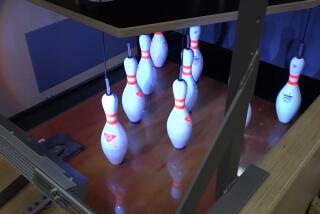ROLLING ALONG : Glenn Allison’s Bowling Story Has a Perfect Ending
For seven years now, bowlers from across the country have been making the pilgrimage to La Habra, the peaceful place, to taste the waters of their Lourdes, so to speak.
Anyone who has ever rattled the gutters with a 16-pound orb or accidentally pressed a re-rack button understands this is as close as you get to a pulsating sun.
These are ordinary-looking strips of hardwood, Lanes 13 and 14 at La Habra’s 300 Bowl. Yet visitors still come and stare in silence, some unbelieving. Others lay their money down at the front desk for the privilege of rolling a few frames on hallowed lanes.
“We had some people just a few weeks ago,” said Brian Markowitz, the alley’s bowling manager. “They were from Oklahoma, and they wanted to know if this was the center Glenn Allison bowled his 900 series. They wanted to bowl on those lanes. They wanted a piece of it.”
The legend of Allison lives and breathes in the Orange County town, seven years--Saturday was the anniversary--after the Thursday night thunder that shook the bowling world in 1982. The memories remain etched in Allison’s mind and he made a special autograph-signing appearance at the alley to commemorate the event.
You’ve heard of blue-chip bowling, no doubt. Well, to mark the occasion, Mickey Curley, La Habra 300’s general manager, arranged for the production of special souvenir stamps--each adorned with Allison’s signature--to be handed out in lieu of blue chips.
A bowling alley never forgets its own.
Rarely a day passes that Allison, 59, isn’t asked about the series. He has been stopped on the street by strangers--pestered for tips and autographs--yet never tires of retelling his favorite bowling story.
“Hell, no,” Allison says, smiling. “It’s the best thing I ever did in my life and I love it. And nobody else has done it yet.”
What Allison did was roll 36 consecutive strikes--three perfect games--in the regular Thursday-night session of the Anchor Girl Trio, the most popular league on the 300’s weekly schedule.
The achievement was extraordinary, although Allison hadn’t exactly walked in off the streets. He was an American Bowling Congress Hall of Fame member at the time, having been inducted in 1979 after winning five Professional Bowlers Assn. titles in a long and successful career.
But nothing suggested he would one night end up touching the Brunswick gates of heaven. Allison had rolled a perfectly mortal 578 series in an-other league earlier that night, but closed with a turkey--three consecutive strikes--in the 10th--a portent of greatness.
Members of the Anchor Girl Trio team that night included the 70-year-old Glada Acocks and Dennis Curley, the general manager’s son--hardly a PBA reunion.
There have been five recorded 900 series but only Allison’s was shot under the pressure and scrutiny of sanctioned league play. His feat stands alone.
Still, he remains haunted by a post-series invasion of ABC investigators, who descended upon La Habra with their Coke-bottle lenses, laboratory bags, nit picks and stuffed shirts. They probed the lanes with an assortment of oil gauges and high-tech instruments.
And those lane scientists left in a huff after the inquisition, refusing to sanction the series because a few outside boards on the lanes lacked the oil content necessary to satisfy their rule book.
The inference, so lacking in subtlety, was that La Habra 300 Bowl had somehow stacked the deck in Allison’s favor by providing an easier groove to the pocket, though automated bowling machines, under the most ideal lane conditions, have never been able to duplicate a 900 series.
Top house bowler Scott Kraye, who witnessed Allison’s miracle series, remembers overhearing an ABC official the next day.
“The guy really had a . . . poor attitude,” Kraye recalled. “He said (the series) was the most ridiculous thing he’d ever seen in his life. He said the lanes were illegal before he even checked them out.”
The popular theory at the time was that the ABC didn’t want to take the record from the beloved Allie Brandt, who had set the series mark of 886 in 1939.
Kraye has his own theory: “Who wants perfection in the record books?”
Now, the ultimate irony: In 1986, the American Bowling Congress did an about-face and altered its regulations, providing for more uniform oiling standards and easier interpretation of its rather cryptic rule book.
Today, a bowling proprietor can spread as much oil as he wishes within 24 feet of the approach board.
“You can put peanut butter down there if you want,” scoffed Bill Burch, owner of La Habra 300.
Alley insiders claim the new rules make it easier than ever to roll higher scores, and are astounded that the ABC would suddenly hand out sanctions like gumdrops.
Last November, Pat Landry of Lansing, Mich., tied Brandt’s record with an 886 series. The ABC quickly sanctioned it. On March 7, Tom Jordan of Paterson, N.J, flirted with Allison’s mark by bowling an 899 series in league play. Again, the ABC recognized the series and it stands as the existing record.
“We’re trying to make everyone happy,” ABC spokesman Mark Miller said, explaining the rule change. “That’s our ultimate goal, to find one specific rule that everyone can be happy with.”
The ABC has no plans to overturn its decision on Allison’s 900 series, however. After his original appeal was denied by the ABC, Allison filed a lawsuit, but the case never made it to court. The judge explained that Allison was a card-carrying member of the ABC and had to abide by its governing decisions.
“I feel sure that if the rules were the same then as they are today, they would have approved it,” Allison said. “I know it would be. There’s no question in my mind.”
Allison thinks the ABC could use a little bureaucratic re-racking, but doubts that his series will ever be officially recognized.
“I don’t expect to see it there,” he said. “Unless they put it there with an asterisk, like Roger Maris. But I really don’t think it will happen.”
The ABC snub, however, has done nothing to smudge Allison’s image, which has taken on mythical proportions. Widespread publicity surrounding the series has waned, but the legend of Allison endures in La Habra, where he roams his alley with a hometown hero’s ease and swagger. And why not? He’s rolled these lanes of La Habra 300 since 1964, so the place seems more an extension of his living room.
“It’s enough for me to know that the world knows I did it,” Allison said. “And believe me, they do. Everyone I’ve talked to thinks it should have been sanctioned. I hear that every day.”
Allison’s Army continues to follow its Pied Piper down the darkest alleys, bowling or otherwise.
Markowitz, a pretty fair bowler who rolled a 676 series the night of Allison’s perfecto, says the general public cannot begin to understand what Allison did one summer’s evening in 1982.
“The concept is insane,” he said of Allison’s feat. “It boggles the mind. You can take the best players on the (pro) tour and let them play here for a year and it would never happen. It is incomprehensible. To me, he is the Babe Ruth of bowling. He put bowling back on the map.”
Kraye agreed.
“People recognize who he is, but they don’t realize what he did,” he said. “I can’t explain the variables. It’s a round ball on round objects. I’ve been bowling 15 years, and I bowled an 850 series once. It was the best I bowled in my life. But this guy threw every ball a strike.”
Allison speaks of the evening in whispered reverence, considering it the supreme experience of a bowler’s life. So why him? Why then? And why La Habra, a city perfectly willing to be left alone so long as it’s never mistaken for Brea?
These remain unsolved mysteries. “I’ve never been able to figure it out,” Allison said. “I have often wondered why me. I mean, I was the guy who did it. Though I had a hole in one the same year, December, 1982, and I’m a lousy golfer. That was my year.”
Allison doesn’t discount the spiritual significance of his perfect series. Others see visions rising. He saw pins falling, one after another. He has even referred to the series as “the miracle.”
“If it hadn’t been for the man upstairs, I couldn’t have carried 36 strikes in a row,” Allison said humbly. “No one’s ever done it before.”
Perhaps it was recompense for three failed marriages and the usual rigors of a professional bowler’s life--the travel, the booze, the talcum powder.
How else do you explain that night? The concentration of a lifetime? Or the fortune of bowling alongside a lifelong friend in Acocks, who only wishes everyone could have witnessed history as she did that night?
Acocks also wishes she had bowled a little better--149, 164, 154--never imagining her scores would be plastered in newspapers and magazines across the country in the weeks that followed.
Of course, she offered the usual excuses, claiming she didn’t want to break Allison’s record-breaking rhythm.
“I just wanted to throw the ball and get off the lanes,” she recalled.
It was Acocks who introduced Allison to bowling at the Whittier Bowling Academy in the early 1940s, although World War II certainly gets an assist.
“I started setting pins when I was 12 years old because all the older boys who (had been) setting pins were off fighting the war,” Allison said.
He rolled a 77 in his first game at age 11 and never looked back.
No sir, you don’t become Mr. 900 without a few twists of fate. Allison’s showed up in the 10th frame of the third game, the 34th roll of the series. His ball rode high toward the pocket and crashed the head pin into the sidewall. Luckily, the pin rebounded to tap the four-pin, which toppled the critical nine.
His last two strikes were dead pocket hits. For good measure, Allison rolled four more strikes, giving him 43 in succession, counting the three he had rolled at the end of his first league series.
The streak ended on what appeared a perfect shot on roll 44.
“I threw it solid in the pocket and left a solid eight pin,” Allison said. “That eight could have stood anywhere. If it stood in the middle of a game, it’s an 879 series.”
But it hadn’t.
Allison remembers he was dazed during the streak, and it was more than a few Crown Royals doing the numbing.
“I had tunnel vision,” he said. “I didn’t see anything. I had the greatest concentration of my career. I had the speed-control necessary to carry the pins. Everything was perfect for me that night. And then there was the man upstairs. . . . I was informed, though I did not know it at the time, that after I started bowling in the third game, I was the only person on the approach on all 42 lanes.”
It was so quiet you could hear 10 pins drop.
Seven years later, Allison still commands respect. Almost all bowlers during a recent open-bowling session stopped and watched as a photographer led Allison down memory Lanes 13 and 14 for a few anniversary pictures. Afterward, several bowlers paid homage to their hero with well-wishes and autograph requests.
What they like about Allison is that he has never changed. He’s a regular guy, still bowling in his regular Thursday night Anchor Girl Trio league, though his partner Acocks, now 77, had to withdraw recently because of back surgery.
Allison retired from the liquor store business two years ago, and now splits his time between work at an Anaheim pro shop distributorship and his involvement with the Western Senior Bowlers Tour, an organization he started last May for bowlers over 50.
Allison figures that he lost thousands of dollars in endorsements because his series wasn’t sanctioned. He sold his ball, the Colombia Yellow Dot, back to the company for $3,000, where it was enshrined at corporate headquarters. But that has been about it. No bowling for dollars here.
La Habra 300 figures it also suffered financially, though it has done everything possible to preserve the memories. Outside, on Whittier Boulevard, the marquee lets you know that La Habra 300 will forever be “Home of the 900 Series.”
Lanes 13 and 14 have been marked with stars for each 300 game. The gate sweeps say Glenn Allison, instead of Brunswick. The mural-sized portrait that used to hang over the lanes has been removed because of remodeling, but will soon be relocated to a more prominent position near the alley’s entrance.
Bowling has been Allison’s life since he was 11, and he’s not ashamed to admit it. This year, he will compete in his 38th American Bowling Congress tournament.
“My goal is to make 50 (tournaments), God willing I live that long,” Allison said. “I’d love to keep on bowling forever. I don’t intend to quit. It’s really been my life. I’ve loved it from Bowl 1. No question, it’s the only thing I’ve wanted to do.”
Allison has given everything to the sport, and all he requests in return is one line with his name on it in bowling’s record bible. And it’s frustrating to know that the solution is as simple as A-B-C.
More to Read
Go beyond the scoreboard
Get the latest on L.A.'s teams in the daily Sports Report newsletter.
You may occasionally receive promotional content from the Los Angeles Times.











